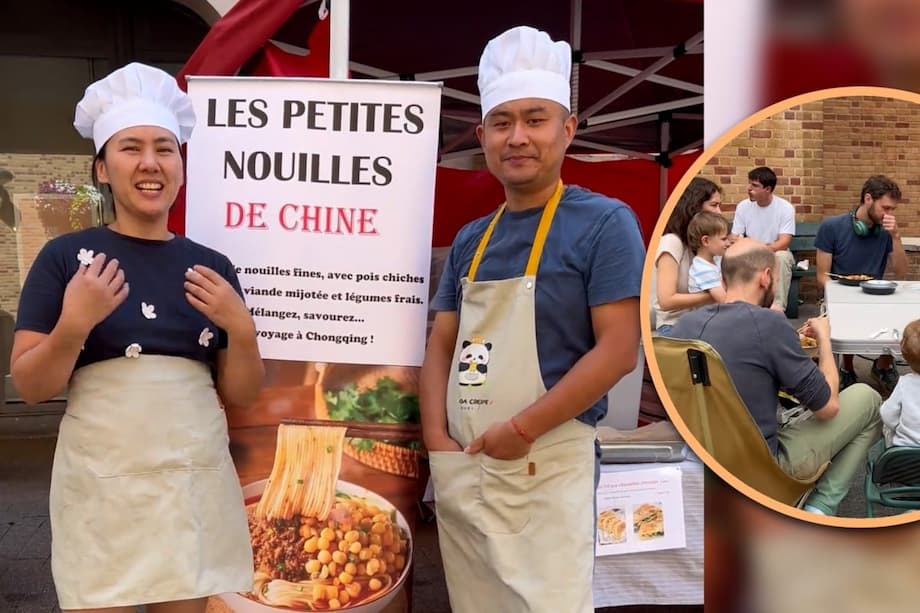A viral noodle stall with academic roots
On busy market days in Belgium, a compact stall simmering with the scent of chili oil and stewed peas has become a magnet for long queues, warm praise, and brisk sales. The cooks behind the counter are not career restaurateurs. They are a Chinese couple, both university trained, who introduced a traditional Chongqing spicy pea noodle to local shoppers and turned it into a runaway success. Reports place their peak takings at more than 1,000 euros (about US$1,200) on top days, with bowls priced between 7 and 9 euros.
- A viral noodle stall with academic roots
- Who are the couple behind the bowls?
- What makes Chongqing spicy pea noodles special?
- Why Belgium responded so quickly
- Revenue at the stall, beyond the top line
- Life between the lab bench and the counter
- How customers describe the taste
- Viral momentum and the social media loop
- What it takes to run a food stall in Belgium
- What this story says about work, migration, and taste
- At a Glance
The husband, Ding, is 37 and specialized in soil management and crop production. After publishing around 30 academic papers, he moved to Belgium for postdoctoral research. He and his wife, Wang, settled there in 2015 and welcomed a child. When steady work beyond research proved elusive, they looked for a practical way to support their family. That decision unlocked an unlikely path: bringing a taste of Wang’s hometown of Chongqing to European markets.
In May, the pair began serving spicy pea noodles at local markets. The dish layers chewy noodles, slow-cooked peas, and a savory pork sauce into a bowl that balances texture and heat. To reach more local palates, Wang toned down the spice while keeping the soul of the recipe. With ingredients prepared in advance, each order is assembled in minutes, letting them move quickly through lines and keep customers returning.
What turned a traditional bowl into a local sensation
Several factors converged. The stall operates only a couple of days per week, which builds anticipation. The price point sits in a sweet spot for a satisfying meal that does not strain a market budget. The story behind the food, a researcher bringing family flavors to a new home, adds authenticity. Viral videos of the stall’s workflow and customers’ reactions spread across Chinese social media, where the couple have attracted tens of thousands of followers. Clips then ricocheted across international platforms, amplifying curiosity among locals who spotted the stall in person.
Who are the couple behind the bowls?
Ding grew up in Jiangsu province and pursued advanced study in agriculture, focusing on soil systems and crop production. That track is rigorous and highly specialized. It also often relies on grant cycles and time limited posts. After his doctorate, he continued as a postdoctoral researcher in Belgium, a common step that can be both exciting and uncertain. During those years he and Wang built a life in Europe. Their child was born there, and they built ties to local communities. While his publication record was strong, steady opportunities outside the research pipeline were harder to find.
Wang, who met Ding at university, had a long standing bond with Chongqing food. She grew up with spicy pea noodles and dreamed of serving it in her own stall. The couple weighed their options and chose to try local markets. They refined the recipe, tested spice levels with European customers, and trained a smooth assembly line to keep wait times short. On their busiest days, the stall can bring in more than 1,000 euros, which reflects both brisk foot traffic and a menu that is easy to scale during rush periods.
They typically operate twice a week. Each bowl is made to order, but much of the work happens before the first customer arrives. Peas are simmered ahead of time until tender, seasonings are portioned, and toppings are set out to move efficiently. A few chairs are available for those who prefer to sit, though many customers eat on the go.
What makes Chongqing spicy pea noodles special?
Chongqing is known worldwide for bold flavors, especially in noodle dishes. While many people associate the region with hot pot and numbing peppercorns, the city’s staple noodles cover a broad range of textures and sauces. Spicy pea noodles, sometimes called pea stew noodles, integrate a rich legume base into the broth or sauce. Split peas are cooked until they break down, then folded into a savory mixture that can include minced pork, soy sauce, aromatics, and chili oil. The peas give body and sweetness that complement the heat. The noodles, usually wheat based, bring chew and hold the sauce well. The final bowl is topped with scallions and sometimes pickled vegetables for brightness.
Heat management is part of the craft. Spice levels that feel normal in Chongqing can overwhelm diners who are new to the cuisine. Wang adjusted the balance, easing off the chili while keeping the dish’s key markers, including the savory depth from the peas and pork, the fragrant oil, and the satisfying texture. That balance is a hallmark of successful cross cultural street food. It allows newcomers to appreciate the core of the dish while staying comfortable, and it gives spice lovers an easy path to ask for more heat.
The speed of service also matters. A dish that can be finished in minutes suits market life, where customers often browse multiple stalls and value short waits. That fits the couple’s approach of prepping core elements in advance. It keeps queues moving and helps revenue on busy days.
Why Belgium responded so quickly
Belgium has a thriving culture of weekly markets and food fairs, from city squares to neighborhood events. Shoppers expect quality and variety, and stalls with a clear identity can stand out fast. The couple’s offering is clear and focused. One signature dish, calibrated to local tastes, at an accessible price. The stall has visual appeal, with a pot of peas and a setup that shows the process without slowing it down.
There is also a practical appeal. At 7 to 9 euros per bowl, a customer can get a filling meal that feels fresh, different from everyday lunch routines, and friendly to a market budget. The combination of salty, savory, and mildly spicy flavors hits the comfort zone many crave. For locals unfamiliar with peas in noodle dishes, the first bite can be surprising in a good way. The peas add body and a gentle sweetness, while the sauce’s meat notes satisfy.
Stories help food travel. The image of a trained agricultural researcher choosing to cook for a living is compelling. It is a reminder that talent and education can take many routes. This narrative amplifies word of mouth, inviting more people to try the dish and share videos or posts.
Revenue at the stall, beyond the top line
Reports of more than 1,000 euros on peak days are eye catching, and they invite a closer look at what that might mean in practice. With prices at 7 to 9 euros per bowl, a stall would likely need to sell between roughly 120 and 150 bowls to cross the 1,000 euro mark. That volume is achievable during sustained rushes, especially if the team can serve several bowls per minute during peaks.
Revenue and profit are different. Ingredients for a dish like this are relatively affordable, especially when bought in bulk, but costs add up. There are peas, noodles, pork, aromatics, chili oil, disposable containers or bowls, and cleaning supplies. Beyond ingredients, market fees, transportation, licenses, and insurance sit in the expense column. The Federal Agency for the Safety of the Food Chain regulates food businesses in Belgium, so vendors must meet hygiene and storage standards, which can include temperature control equipment and proper food handling.
Margins vary by stall and location. Simple menus with efficient prep can keep labor modest and waste low, which helps. On a strong day, the couple’s take home after costs would be lower than the headline revenue but still meaningful for a two day weekly operation. Multiply a strong day by two market days per week, and the monthly intake can be significant for a small family enterprise, even after expenses. Slow days still happen, so the weekly picture can fluctuate with weather, holidays, and market schedules.
Life between the lab bench and the counter
For many early career researchers, the transition from postdoctoral roles to permanent positions is uncertain. Contracts are often fixed term, competition is intense, and openings are limited. Many researchers build diverse skills that transfer into other fields. Food businesses benefit from the same qualities that research cultivates: planning, careful measurement, iteration, and attention to results. Wang captured this plainly when she described the stall as work that supports their family, comparable in mindset to research in its focus on problem solving and perseverance.
The couple’s routine blends preparation and public service. Before market day, they prep large batches of peas and sauces. On site, they keep hot items at safe temperatures and maintain a clean workspace. The rhythm rewards discipline. It also leaves room for continued job searching, since the stall runs on set market days. Reports say Ding still looks for suitable roles while helping run the business, a reminder that family economies can be a mix of paths.
How customers describe the taste
Reactions have been warm and enthusiastic, which helped the stall go viral. In one widely shared clip, an elderly woman who had trouble with chopsticks smiled after her first bites and offered a simple verdict.
She said her piece in front of the camera, then the video cut to a closeup of the bowl.
These are the best Chinese noodles I have ever had.
Another regular spoke with curiosity rather than nostalgia. He focused on a single ingredient and the surprise of enjoying it in a new way.
I never knew peas could taste this good.
Wang, who grew up with the dish, framed their work as steady and purposeful rather than flashy. In a clip shared with followers, she explained their goal is straightforward.
Running a stall is no different from research. We are simply supporting our family.
Viral momentum and the social media loop
The couple’s videos have drawn more than 78,000 followers on Chinese platforms. That attention spills into local interest. Tourists sometimes plan stops around food that trends online. Locals who see the lines and phones held high come to watch and then to taste. Social media rewards visuals, and the stall’s elements are photogenic. The glossy chili oil, the steam lifting from a fresh bowl, the scoop of yellow peas, and the moment a customer takes a first bite. Those beats play well across short clips.
Virality is not a business plan by itself. It can ebb and flow quickly. What sustains a stall is consistency, fair pricing, and reliable service. The couple’s operation, built around a single polished item, suits that reality. Their focused menu keeps quality consistent and service fast, which aligns with what markets value.
The online reaction also sparked conversations about Chinese food beyond big city staples. Viewers noted how many regional dishes remain underrepresented abroad. The story of one stall hints at wider potential for dishes that are approachable, affordable, and well executed.
What it takes to run a food stall in Belgium
Belgian markets are regulated environments with standards designed to protect public health. Vendors typically need registration and inspection under the Federal Agency for the Safety of the Food Chain. Requirements cover safe storage temperatures, clear separation of raw and cooked items, clean water for washing, and traceability of ingredients. Market organizers also set rules about stall placement, power use, waste handling, and operating hours.
For a noodle stall, practical steps include transporting hot items in insulated containers, using food safe thermometers to check temperatures, and keeping utensils spotless. Preparation space back at a licensed kitchen or approved facility is often key, since much of the cooking happens before market hours. Insurance is common, both to protect the business and to meet organizer requirements.
These basics shape the workday. The couple’s efficiency comes in part from thoughtful preparation. Measuring portions keeps costs predictable. Pre made components speed service without sacrificing flavor. Small touches, like a few chairs for those who need a seat, create a welcoming feel without slowing the line.
What this story says about work, migration, and taste
Migration stories often trace how people carry skills and traditions into new settings. Here, advanced academic training and a cherished hometown dish meet a Belgian market culture that rewards quality and clarity. The couple’s path highlights several wider themes. Career uncertainty can push talented people to try new ventures. Food, when shared well, can connect strangers quickly. Adaptation, whether in a lab or a kitchen, is both creative and practical.
For many readers, the headline number stands out most: 1,000 euros a day. Beneath that figure sits careful work and a smart fit between product and place. The dish is distinctive but not intimidating. The stall runs on a schedule that builds demand. The couple’s story travels well through short videos. Together, those pieces created momentum. If that momentum holds, the stall could become a dependable fixture of local markets and a small case study in how regional Chinese dishes can thrive abroad when presented with care.
At a Glance
- Chinese couple in Belgium turned a Chongqing spicy pea noodle stall into a local hit
- Peak daily takings reported at more than 1,000 euros (about US$1,200)
- Bowl prices set between 7 and 9 euros, with service tailored for short waits
- Ding, 37, has a PhD and postdoctoral work in soil management and crop production
- Wang grew up with the dish and adjusted spice levels for local tastes
- Stall operates around two days per week at local markets
- Viral videos helped attract more than 78,000 followers on Chinese social media
- Customers praised the flavor and texture, with some calling it the best Chinese noodles they have had
- Food stall operations in Belgium require hygiene and safety compliance under national rules
- The story reflects how training, tradition, and smart adaptation can support a family business




